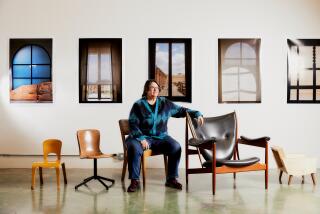Chair Apparent : Being able to take a seat in style and comfort hasn’t always been an option for the masses.
- Share via
“I have Crawford chairs by Goodman Carlton that are very boudoir-ish. They’re yellow velvet with red buttons and remind me of Betty Boop.”
--Scott Ian of Huntington Beach, lead guitarist with the rock group Anthrax.
Ever since humans started walking around, they have been eager to sit down. But for thousands of years, only the rich and powerful could afford chairs. Peasants had to make do with the floor, a bench, a log or a bale of straw.
Art historian Patricia Platt of Irvine studies chairs. The ancient Egyptians were the first to create elaborate chairs, many of which are found in their tombs. An ancient thronelike Egyptian armchair from the tomb of rulers Yuya and Tuya, New Kingdom (c. 1575-1075 BC) had a wooden frame decorated with gold foil with a seat of interlaced cords and a veneered back.
The Greeks, on the other hand, developed a simpler, more portable chair, the klismos, in the 6th century BC, which was without arms and stood on inward-curving, sabre-shaped legs with a curved back for comfort. A similarly designed chair is still used today.
“This was the most influential chair throughout history,” explains Greek-born Irini Vallera-Rickerson, who teaches at UC Irvine. “It was the first instance of ergonomics or the concept of furniture comfortably fitting the human form.”
*
“I like chairs that are not too form-fitting, have no arms and are soft. Right now my favorite chair is bright green velour. I also like a Queen Anne chair I picked up for $20 and a small vanity chair. After I get through with the chairs I give them away.”
--Naida Osline, director of the Huntington Beach Art Center.
After the fall of the Greek and Roman empires, it was centuries until chairs reappeared, and then they were both status symbols and functional pieces, with status often more important than function.
Chinese aristocracy of the Ming dynasty (1368-1644) had a portable reclining armchair, the zuiwengyi, or “drunken lord’s chair” to collapse into after an evening of merriment. The Ming Dynasty is considered the Golden Age of classic Chinese furniture, and chairs had wide seats, arm rests and high backs, usually combined with footstools.
In Europe until the late 16th century, chairs were rare for everyone. During the Middle Ages, chairs were regarded as a symbol of authority and only the owner of the house and a few distinguished guests sat in them. The largest castles seldom had more than two chairs.
It wasn’t until the 18th century that styles on a more human scale began to emerge. France’s Louis XV rococo chairs were designed for comfort, something that hadn’t been a requirement except for the ancient Greeks.
Furniture lines were curving, not straight, and all armchairs, whether upholstered or caned, usually had upholstered elbow rests. In fact, upholstery had never been more comfortable.
*
“Two matching overstuffed chairs in my living room are my favorite chairs. I picked them up at an estate sale, and they are very comfortable.”
--Marily Wilson, a fashion consultant in Newport Beach.
Around the 18th century, the middle class began to attain prosperity and bought chairs for their homes as well. The rococo chairs were smaller and could be adapted to smaller rooms, whereas Louis the XIV’s furniture was monumental and meant to glorify the king.
In England, Queen Anne pieces, such as walnut wing chairs fitted with loose seat cushions, were popular.
By the 19th century, comfort was desired even more. This became the age of the upholsterer. Trade routes throughout the world made exotic fabrics more affordable and the styles of entertaining relaxed and required new furniture.
High tea was one form of entertainment that required intimate furniture, and highly upholstered pieces became the rage during the reign of Queen Victoria.
With the Industrial Revolution came the development of spring construction, and a new era of comfortable furniture. It was then that the machine took over furniture construction and made it more affordable.
*
“My 19th century American pine rocking chair is very comfortable and good for people with back problems. It’s like the one you often see John Kennedy pictured in.”
--Dudley Johnson, an investment advisor with Dean Witter Reynolds in Newport Beach.
As a reaction to all the over-stuffed chairs and the machine, the Arts and Crafts Movement of the 19th century and the modernists of the 20th century created furniture with beautiful, clean lines that was often uncomfortable.
Today this furniture is expensive, while much comfortable furniture such as beanbag chairs and futons are inexpensive. Thus, we have come full circle with the rich able to afford uncomfortable, “art” chairs to admire, while the rest of the population is looking for a comfortable place to sit.


